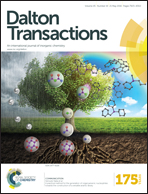Controlled synthesis of mixed-valent Fe-containing metal organic frameworks for the degradation of phenol under mild conditions†
Abstract
A series of MIL-53(Fe)-type materials, Fe(BDC)(DMF,F), were prepared by using different ratios of n(FeCl3)/n(FeCl2), which have varied amounts of Fe2+ in their frameworks. From FeCl3 to FeCl2, the structures of the synthesized samples transform from MIL-53(Fe) to Fe(BDC)(DMF,F). Along with this structure transformation, the crystal morphology goes through a striking change from a small irregular shape to a big triangular prism. This phenomenon indicates that the addition of FeCl2 is beneficial for the formation of a Fe(BDC)(DMF,F) structure. The catalytic activity of these iron-containing MOFs was tested in phenol degradation with hydrogen peroxide as an oxidant at near neutral pH and 35 °C. The degradation efficiency of these samples increases gradually from MIL-53(Fe) to Fe(BDC)(DMF,F). 57Fe Mössbauer spectra reveal that Fe2+ and Fe3+ coexist in the Fe(BDC)(DMF,F) framework, and the highest amount of Fe2+ in the sample prepared with mixed FeCl3 and FeCl2 is 26.0%. The result illustrates that the amount of Fe2+ in the samples can be controlled using varied n(FeCl3)/n(FeCl2) in the feed. The diverse amount of Fe2+ in this series of FeMOF materials exactly explains the distinction of reaction efficiency. The iron leaching tests, structures of the fresh and used catalysts, and the data of the recycling runs show that the Fe-containing MOFs are stable in this liquid-phase reaction.


 Please wait while we load your content...
Please wait while we load your content...